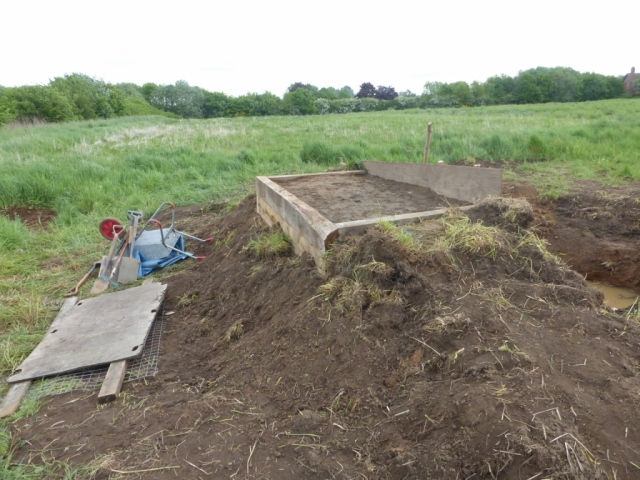Having constructed a first bee bank in April 2015 and learning a lot from doing it we decided to build a second. Andrew Cutts of the Buglife Urban Buzz project in York kindly offered their financial support. After some investigation, debate and constructive dialogue we all agreed that there was nothing well documented that covered the types of aculeates we were aiming to attract such as solitary bees (of which there are around 240 species) including mining bees, so we were out on our own…
From our earlier ground investigations we believed there was a layer of sticky sand under the eighteen or so inches of top soil in the Cornfield arable, and we had extracted and used this when building the 2015 model. So we’d again hire a digger and Don could scraped off the turf with this before digging a large hole from which to build a couple of large piles of sand, and this could be prepared before the manual work.
The main concern we had was how to hold the sand together with the cement we would be using to give it some sticking power and create a flat face looking south. The 2015 model had been held together with some shuttering until it set but was only about two feet high and the new one was planned to be a couple of metre wide, a metre high and a metre deep. There would also be the face of the hole we had got the sand from. We settled on using ten oak sleepers, having five cut in half and screwing them together to build a bunker into which to load the sand and cement in layers. We’d also procured a good selection of clay drain pipes to be packed with sand.
Phase 1
The first job was to use the digger to scrape turf off the area and pile to one side. The digger extracted the soil before the sand was dug out and piled on a sheet nearby. The first of the sleepers were now settled in place and screwed together, this was repeated until we were five sleepers high (or had a metre depth to the bunker. Using 2.4 metre sleepers with sides then of 1.2 metres, we had a very stable structure.
Phase 2
A week and a day later and in less sunny weather we met with volunteers from York Cares who would be doing the first shift of the graft.
The task now was to fill the oak sleeper bunker with layers of sand and cement in the hope that it would cure and produce the suitable sandy cliff face for the aculeates we wanted to attract.
The team set to it adding extra screws to the sleepers, battening the shuttering to the front of the bunker, filling the clay pipes that would be extra habitat and primarily filling the bunker and tamping it down.
In the afternoon a second team from the Yorkshire Bank were left with about two thirds of the bunker still to fill, along with piling the turf and pipes adjacent to it to landscape the structure.
By the time all were done the structure was largely ready and all we needed to do was remove the shuttering in a week’s time when hopefully everything has hardened. The clay drain pipes (packed with sand) can be seen to the right and left in the photograph below, the original bank on the right. There are also possible suitable nesting faces in the area below the constructed bank.
The intention is to add a ‘green roof’ to provide a nearby pollen source for the bees, and develop the planting nearby to assist them. Luckily there are lots of flowers coming through in the hedgerow and in the nearby Cornfield grassland.
Our thanks go to York Cares for organising the team challenge and doing it, along with getting a team from Yorkshire Bank to assist. Our thanks go also to Buglife’s Urban Buzz project for funding it – and we hope it is what they were expecting.













Pingback: The Grand Rawcliffe Bee Bank Hotel | The Friends of Rawcliffe Meadows